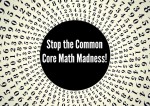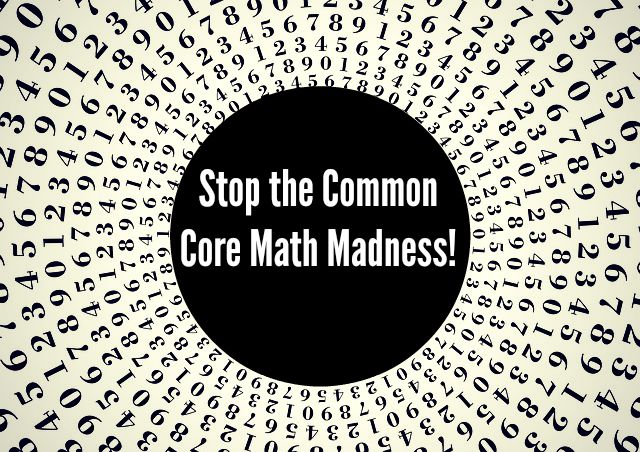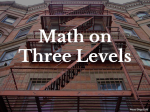Everywhere, parents are abuzz with complaints about Common Core math. Parents are astonished how teachers can be instructing their kids on a math method that complicates an easy problem.
I’ve been flummoxed at the uproar. I went to have a look at the common core standards. I chose 2nd grade standards since that seems to be a grade where the potentially problematic approach is taught.
Here are some of the 2nd grade standards from Corestandards.org:
Use place value understanding and properties of operations to add and subtract.
CCSS.MATH.CONTENT.2.NBT.B.5
Fluently add and subtract within 100 using strategies based on place value, properties of operations, and/or the relationship between addition and subtraction.CCSS.MATH.CONTENT.2.NBT.B.6
Add up to four two-digit numbers using strategies based on place value and properties of operations.CCSS.MATH.CONTENT.2.NBT.B.7
Add and subtract within 1000, using concrete models or drawings and strategies based on place value, properties of operations, and/or the relationship between addition and subtraction; relate the strategy to a written method. Understand that in adding or subtracting three-digit numbers, one adds or subtracts hundreds and hundreds, tens and tens, ones and ones; and sometimes it is necessary to compose or decompose tens or hundreds.Add MediaCCSS.MATH.CONTENT.2.NBT.B.8
Mentally add 10 or 100 to a given number 100-900, and mentally subtract 10 or 100 from a given number 100-900.CCSS.MATH.CONTENT.2.NBT.B.9
Explain why addition and subtraction strategies work, using place value and the properties of operations.
In this list (only part of the 2nd grade standards), I see references to strategies and mental math. These strategies are what many are protesting.
This is an example of the issue many parents have with Common Core:
So what are we actually dealing with here? Are teachers overcomplicating things or is something else going on?
I see this video and I totally understand how to do the problem on the left. Why? Because this is the way that Singapore math teaches. It focuses on teaching a conceptual understanding prior to doing the standard algorithm on the right. Breaking apart numbers and putting them back together is an excellent exercise in mathematical thinking. This strategy of breaking apart numbers and manipulating them leads to greater understanding of place value and mental math acuity.
Common Core standards started development in 2008. Singapore Math was developed in the 1980s. Maybe Common Core adopted some of the methods employed in Singapore, but these strategies existed before Common Core. Singapore’s high-ranking in math led some in the US to look at the methods that were used in Singapore.
The method of breaking apart numbers and manipulating them is not Common Core. More accurately, you could say that these “new methods” are conceptual math. Common Core employs some conceptual math goals. But these methods did not originate with Common Core.
Traditional math instruction focuses on doing rote operations until they are mastered. I was taught with a traditional method in school and it wasn’t difficult for me to get an A in math. I just did the problems correctly in the way I was taught. Even though math was an easier subject for me, I didn’t like it. It was boring. I was fully capable of knowing how to do the problems, but I didn’t know why the problems worked. I just needed to remember steps and formulas.
I started using Singapore Math with my kids about 5 years ago. This new way of doing math was quite different from what I had learned. But did that mean that it was wrong? As I started doing the math with my kids, I started to do something that I hadn’t done before. I started to learn to think mathematically. I had always needed to do math problems on a piece of paper. Mental math wasn’t something that I could do. Turns out that I could learn to manipulate numbers mentally. It wasn’t easy to make the switch from traditional math thinking to conceptual math thinking, but as I started to learn the strategies and understand the why of math, it became easier. Not only that, but I also started to develop a love for math that didn’t exist with traditional math instruction.
Singapore math doesn’t neglect the traditional ways of doing problems, but they are presented after a child understands how to break apart the numbers to solve the problem. This leads to a greater understanding of the why behind the math. Singapore also focuses on problem solving rather than pages of math problems. I’ve found that pages of math problems aren’t necessary when you understand the why of math.
Now my older two kids are digging even deeper into mathematical thinking with Art of Problem Solving’s math. I’m still learning along with them and I hope to do so for years to come.
So back to Common Core. Is this a beast that is ruining children’s math skills all over the country? Or perhaps, is this “new method” a way to teach kids mathematical flexibility and understanding?
Common Core math has many up in arms against this “weird” method. I can’t count how many little videos I have seen of parents sharing their children’s weird math problems and wondering what in the world the teachers are doing. Instead of being enraged at the departure from the traditional approach, perhaps we should learn along with our kids. It may transform our mathematical understanding in the process.








I completely agree. The problem isn’t the math itself but that the parents don’t know the methods being used and the himework instructions don’t define terms so the parents can’t answer questions for the kids. If they sent home an explanation of the homework, a) the kids could refresh themselves on the methods introduced in the classroom, and b) the parents would be able to figure out what the questions were asking for. In my opinion, the math standards are completely sound, it’s whether the Fed gov’t should be paying States to adopt their preferred sequences and such that is the question, and there are pros and cons to each side of that argument.
Thanks for this excellent article!
My own child started out with RightStart Math (Levels B, C, and D), followed by a brief stint of Singapore Standards Edition (deadly dull for my kid), followed by a year and a half of MEP (a British adaptation of a brilliant Hungarian math program). At that point, at age 12, she did a math placement test and tested “ready for high school algebra; consider doing additional testing to determine whether student is ready for even higher placement.” In fact, my child had already done some elementary algebra in MEP Year 4, and she easily and effortlessly mentally manipulated variables while, sitting beside her, I plodded through the same math problems doggedly applying the rules I memorized in Algebra 1 in high school.
When parents started complaining about Common Core math, I took a look at some of the complained-about problems posted on the web. I quickly realized that Common Core math used some of the same approaches used in RightStart and MEP, approaches that get kids “thinking mathematically.” These approaches result in kids who thoroughly understand and enjoy math, and kids who can often “figure out how to figure it out” when encountering completely unfamiliar math problems.
The Common Core standards have some serious shortcomings. Common Core was imposed from the top down. Common Core textbooks vary in quality from better to worse. The implementation of Common Core has been a disastrous mess, a whole series of stupid missteps that have hurt kids, parents, and teachers.
So I understand the outrage about Common Core.
But I completely agree with your statement, “Instead of being enraged at the departure from the traditional approach, perhaps we should learn along with our kids. It may transform our mathematical understanding in the process.”
I got A’s in math in school…but my “traditional” math instruction turned me into a rigid “just tell me how to solve it, I’ll memorize the procedure, and then I’ll get all the problems right” kid who resented teachers who wanted me to actually THINK in math class, not just memorize. From 6th grade up, I didn’t enjoy math.
Luckily, I found RightStart Math and MEP, two great non-traditional math programs, and doing them with my child has tremendously improved my math skills and my enjoyment of math! (But my kid can still whiz through math problems leaving me far behind…now that she’s a teenager, that gives her great satisfaction!)
Thank you so much for this post. I get so frustrated hearing uninformed parents constantly berate Common Core initiatives. Many parents are, I think, just insecure about a departure from the traditional and about their own insufficiencies. Why would you not want your child to know multiple ways of solving problems?? I am in no way a Common Core ambassador but I do ask parents to get informed. Don’t just blindly object to somethig because it’s unfamiliar. Do some research and figure out why other countries are surpassing our students in math. Once your research is performed, feel free to make an informed decision about the benefit of any of the Common Core standards.